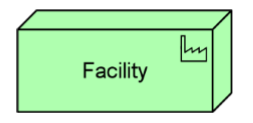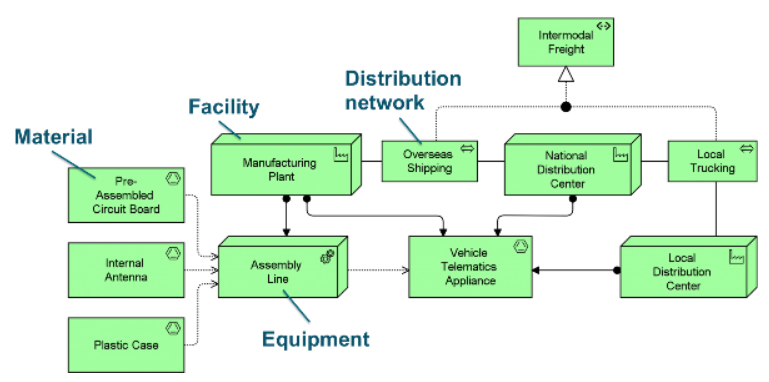The physical elements are added as an extension to the Technology Layer for modeling the physical world. There are only active and passive structure element concepts in the physical elements and there are no separate physical behavior elements are defined here in this layer.
The behavior elements from the Technology Layer (technology function, process, interaction, service, and event) are used to model the behavior of all nodes, including physical equipment.
Relationship of Concepts in Technology vs Physical Layer
The path element from the Technology Layer models the relation between two or more nodes, through which these nodes can exchange information or material.
The inter-relationships of physical elements are mainly formed by the logistics infrastructure. The physical realization of a path is modeled with a distribution network.
i.e., a physical connection between two or more pieces of equipment (or other physical networks). This can be used to model:
- Rail or road networks
- Water supply
- Power grid
- Gas network
Active Structure Elements
Equipment Concept Notation
Equipment represents one or more physical machines, tools, or instruments that can create, use, store, move, or transform materials.

Equipment comprises all active processing elements that carry out physical processes in which materials are used or transformed which has the following characteristics:
- Equipment is a specialization of the node element from the Technology Layer, such as, a combination of IT infrastructure i.e. devices, system software, or physical infrastructure, i.e. an MRI scanner at a hospital, a production plant with its control systems, etc.
- Material can be accessed (e.g., created, used, stored, moved, or transformed) by equipment.
- Equipment can serve other equipment, and also other active structure elements such as business roles and actors, and facilities can be assigned to equipment.
- A piece of equipment can be composed of other pieces of equipment. Equipment can be assigned to (i.e., installed and used in or on) a facility and can be aggregated in a location.
The name of a piece of equipment should preferably be a noun.
Facility Concept Notation
A facility represents a physical structure or environment which is a specialization of a node. It represents a physical resource that has the capability of facilitating (e.g., housing or locating) the use of equipment.

Facilities have an important role in production or distribution processes. Examples of facilities include:
- Factory
- Laboratory
- Warehouse
- Shopping mall
A facility has the following characteristics:
- A facility may be composite; i.e., consist of sub-facilities.
- A facility can be interconnected by distribution networks.
- A facility can serve other facilities, and also other active structure elements such as business roles and actors, and locations can be assigned to facilities.
- A facility can be composed of other facilities and can be aggregated in a location.
- The name of a facility should preferably be a noun referring to the type of facility; e.g., “Rotterdam harbor oil refinery”.
Distribution Network Concept Notation
A distribution network represents a physical network used to transport materials or energy.

A distribution network has the following characteristics:
- A distribution network represents the physical distribution or transportation infrastructure.
- It embodies the physical realization of the logical paths between nodes.
A distribution network connects two or more nodes. - A distribution network may realize one or more paths.
- A distribution network can consist of sub-networks and can aggregate facilities and equipment, i.e. railway stations and trains that are part of a rail network.
Behavior Concepts
As I mentioned above, there are only active and passive structure element concepts in the physical elements and there are no separate physical behavior elements are defined here in this layer.
The behavior elements from the Technology Layer (technology function, process, interaction, service, and event) are used to model the behavior of all nodes, including physical equipment.
Passive Structure Concepts
Material Concept Notation
Material represents tangible physical matter or physical elements.

Material concepts has the following characteristics:
- Material represents tangible physical matter, with attributes such as size and weight.
- It is typically used to model raw materials and physical products, and also energy sources such as fuel.
- Material can be accessed by physical processes.
- Pieces of material may be composed of other pieces of material.
- The name of material should be a noun.
Physical Layer Concept Example
An Assembly Line is modeled as equipment, and installed at a facility Manufacturing Plant, makes use of materials Pre-Assembled Circuit Board, Internal Antenna, and Plastic Case to produce material Vehicle Telematics Appliance.

The appliance is initially located at the Manufacturing Plant facility, is subsequently transported to the facilities National Distribution Center and Local Distribution Center, making use of the distribution networks Overseas Shipping and Local Trucking. These distribution networks together realize the path Intermodal Freight.
Related Resources
The following resources may help you to learn more about the topic discussed in this page.
- What’s New in ArchiMate 3? – An overview of changes in ArchiMate 3.0
- Full ArchiMate Viewpoints Guide (Examples Included) – A ‘handbook’ of ArchiMate Viewpoints, which lists and explains all to 23 example ArchiMate Viewpoints in detail
- ArchiMate 3.0.1 specification
- Learn more about Visual Paradigm‘s ArchiMate support
- Visual Paradigm on YouTube